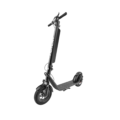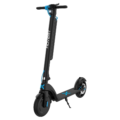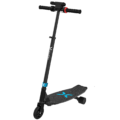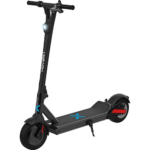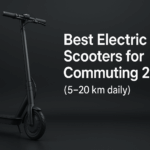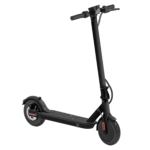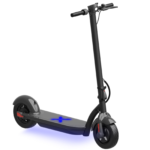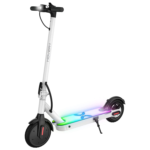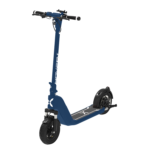- Home
- Scooters
- Electric Scooters
- Hover-1 Highlander Pro
Hover-1 Highlander Pro
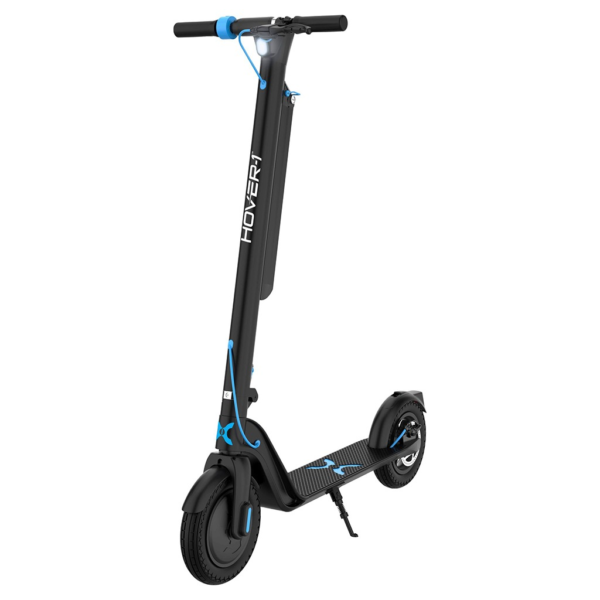

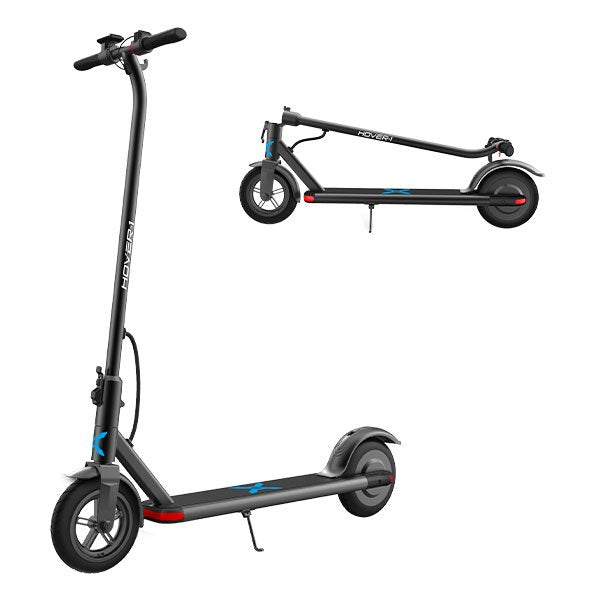
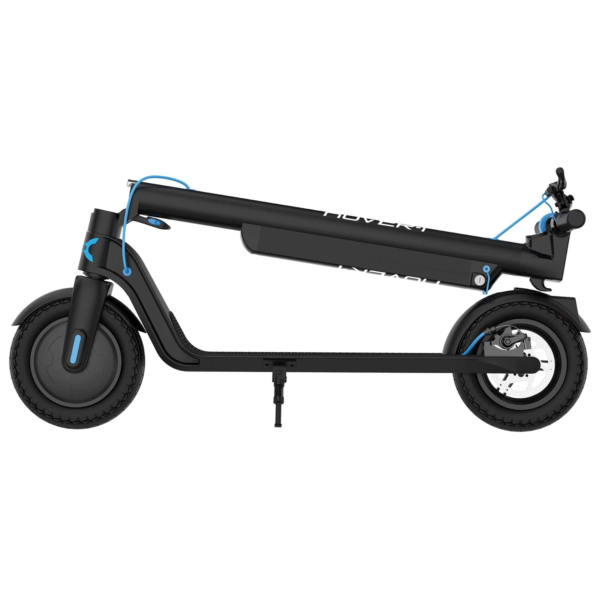
- Battery Range: 18 miles (29 km)
- Top Speed: 15 mph (24 km/h)
- Motor Power: 350 W
- Weight Capacity: 264 lb (120 kg)
- Charging Time: ~6 h
- Scooter Weight: 23.3 lb (10.6 kg)
PROS
- 10″ pneumatic tires for comfort
- Disc + foot brake
- 350W brushless motor
- LED headlight & display
- 15° climb rating
- 264 lb capacity
CONS
- No official IP rating
- Single mechanical brake
- No app connectivity

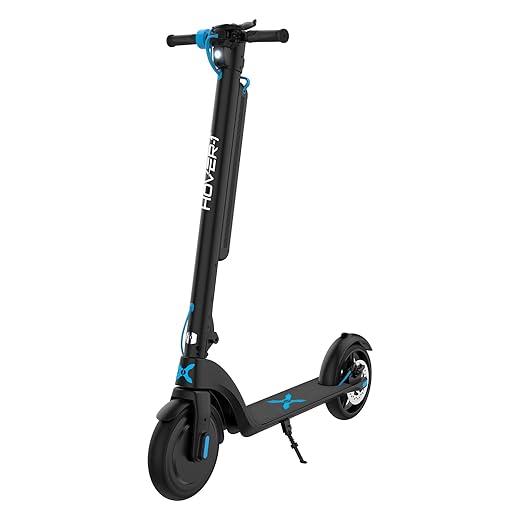
Table of contents
- What Is the Hover-1 Highlander Pro?
- How the Hover-1 Highlander Pro Works
- Key Specifications
- Design & Build Quality
- Performance Fundamentals
- Battery, Range & Efficiency
- Ride Quality & Comfort
- Braking & Safety Features
- Portability & Daily Usability
- Maintenance & Care
- Weather & Seasonal Considerations
- Hover-1 Highlander Pro vs Alternatives
- Who the Hover-1 Highlander Pro Is (and Isn’t) For
- FAQs
- Glossary
- Final Thoughts
If you want a simple, full-size commuter scooter that prioritizes stability, predictable controls, and a removable battery, the Hover-1 Highlander Pro fits the brief. It is a 10-inch, rear-disc–brake scooter with a 350W hub motor and a clear LCD cockpit that shows speed, mode, and battery level. Because it sticks to proven components and transparent specs, the Hover-1 Highlander Pro suits new riders, daily short-hop commuters, and students who need a durable, no-drama ride.
What Is the Hover-1 Highlander Pro?
At its core, the Hover-1 Highlander Pro is a foldable, everyday electric scooter built around a 350-watt, brushless rear hub motor and a 37V, 10Ah lithium-ion battery. Moreover, it rides on two 10-inch pneumatic (air-filled) tires for better shock absorption than solid rubber wheels. The frame folds at the base of the stem, and the battery sits inside the steering column where it’s easy to remove for charging or storage. You get a handle-actuated rear disc brake and a mechanical foot (stomp) brake, a bright LCD display, an integrated headlight and rear brake light, and three speed modes: Eco (about 12 mph / 19 km/h), Normal (about 15 mph / 24 km/h), and Sport (up to 18 mph / 29 km/h).
Unlike many ultra-compact “last-mile” scooters, the Highlander Pro uses a full-length deck and tall steering column that feel natural to adult riders. Accordingly, the official top speed is up to 18 mph (29 km/h) and the rated range is up to 18 miles (29 km) under favorable conditions. The scooter itself weighs about 32 lb (14.5 kg) and supports riders up to 264 lb (120 kg). Together, those numbers place it firmly in the practical commuter class—fast enough for urban arterials, yet manageable for apartment stair carries and trunk storage.
How the Hover-1 Highlander Pro Works
Think of the Highlander Pro like a compact, electric bicycle drivetrain simplified into a scooter. Consequently, each major component plays a clear role:
- Motor: The 350W brushless hub motor sits in the rear wheel. Because it’s brushless, it runs quietly and efficiently, with fewer wear parts than older brushed motors. As a result, power delivery is linear: a gentle thumb press gives a gentle roll, and a full press gives brisk acceleration.
- Controller: Hidden in the frame, the controller is the small computer that meters battery power to the motor. It also interprets throttle input, switches speed modes, and monitors temperature. If the controller gets hot, the display can show a high-temperature warning so you can ease off and let the system cool before continuing.
- Battery: A 37-volt, 10-amp-hour pack stores roughly 370 watt-hours of energy (volts × amp-hours). Notably, it slides into the steering column and can be removed. Because the charge port is on the battery, you can charge off-scooter at your desk or inside while the scooter stays in a garage or hallway.
- Throttle: A right-hand thumb throttle precisely modulates speed. In Eco, it limits peak speed to around 12 mph (19 km/h) to stretch range. In Normal, it lands near 15 mph (24 km/h). In Sport, it unlocks the full 18 mph (29 km/h) when conditions allow.
- Brakes: A hand lever actuates a cable-driven rear disc brake for stopping power and control. Meanwhile, a rear fender foot brake serves as a backup or a way to scrub speed on gentle descents. Because the system is mechanical, it’s easy to maintain with basic tools.
Everything runs from the cockpit: long-press the power button to start, tap to toggle modes, and glance at the LCD for speed, battery bars, and status icons. Additionally, because the speed unit can be switched, you can ride in mph or km/h without doing mental math.
Key Specifications
All values below reflect the official published details for the Highlander Pro; dual units are included for clarity.
General
| Item | Value |
|---|---|
| Model | H1-HRPRO |
| Net Weight | 32 lb (14.5 kg) |
| Max Rider Weight | 264 lb (120 kg) |
| Minimum Rider Weight | 44 lb (20 kg) |
| Tire Type | Pneumatic (air-filled) |
| Tire Size | 10 in (front & rear) |
Performance & Power
| Item | Value |
|---|---|
| Motor | 350W brushless rear hub |
| Top Speed (Sport) | Up to 18 mph (29 km/h) |
| Speed Modes | Eco ~12 mph (19 km/h), Normal ~15 mph (24 km/h), Sport ~18 mph (29 km/h) |
| Drive | Rear-wheel |
Battery, Charging & Electrical
| Item | Value |
|---|---|
| Battery | 37V 10Ah lithium-ion (~370 Wh, calculated) |
| Battery Location | Removable pack in steering column |
| Charge Time | Up to 6 hours |
| Charging | 100–240V AC input (50/60 Hz), single-port charger |
| Operating Temp | 32–104°F (0–40°C) |
| Charging Temp | 32–104°F (0–40°C) |
| Storage Temp | −4–104°F (−20–40°C) |
Build & Dimensions
| Item | Value |
|---|---|
| Open Size (L×W×H) | 41.73 × 16.5 × 46.06 in (106 × 42 × 117 cm) |
| Folded Size (L×W×H) | 41.73 × 16.5 × 18.9 in (106 × 42 × 48 cm) |
| Frame | Folding stem with locking clip |
| Deck | Full-length platform with kickstand |
Safety & Control
| Item | Value |
|---|---|
| Brakes | Handle-activated rear disc + mechanical foot |
| Lighting | Front headlight and rear brake light |
| Display | LCD speedometer with battery bars, mode icon, and warning indicators |
Features & Extras
| Item | Value |
|---|---|
| Speed Units | mph or km/h selectable |
| Modes | Eco / Normal / Sport |
| Battery | Removable for off-scooter charging |
| Cockpit | Bell, thumb throttle, power/mode button |
Warranty & Compliance
| Item | Value |
|---|---|
| Manufacturer | DGL Group, Ltd. (Hover-1) |
| Warranty | Limited manufacturer warranty |
| Notes | No factory reflectors; follow local rules and add reflectors if required |
Design & Build Quality
The Hover-1 Highlander Pro looks straightforward because it is. The frame centers around a thick steering column that doubles as a battery housing. This keeps mass forward and low; consequently, it helps tracking stability. Because the battery is removable, it also introduces a practical benefit: you can carry just the pack inside to charge while leaving the scooter in a bike room or garage. In addition, the fit-and-finish is consistent with a commuter’s tool—clean welds, a robust folding joint, and a deck that’s long enough for staggered feet.
The cockpit is tidy and readable. The LCD sits centered, with a bell and left-hand brake lever on one side and the throttle and power/mode button on the other. Furthermore, the display’s mode colors make it obvious which speed cap you’ve selected, and the battery bar graph gives quick “how far can I push it” feedback. Because the speed units can switch, you won’t need to convert mph to km/h in your head.
Down below, the 10-inch pneumatic tires and rear disc rotor dominate the look. Those big air-filled tires matter; they add compliance over rough asphalt and reduce the harshness you get from small solid wheels. The rear fender doubles as a foot brake and carries a tail/brake light for visibility when slowing. Hardware access is sensible: you can service the mechanical brake with common tools, and you can remove the battery without taking the scooter apart.
Even the folding system is rider-friendly. The clip and latch are large enough to manipulate with gloved hands, and the folded height of under 19 inches (48 cm) makes closet storage less awkward. Finally, the deck includes a kickstand that props the scooter securely without an overly tall lean angle.
Performance Fundamentals
Because the Highlander Pro uses a rear hub motor, the first push feels planted. Rear-drive scooters tend to step forward without tugging the bars, and that’s the vibe here. In Eco, the scooter accelerates gently and holds around 12 mph (19 km/h). New riders will appreciate that calm response when starting among pedestrians. In Normal, the motor adds some punch yet remains smooth; therefore, it’s the mode many riders will keep selected for neighborhood streets and shared paths.
Switch to Sport when you need a quicker merge or a longer suburban segment. The Hover-1 Highlander Pro will pull up to an indicated 18 mph (29 km/h) on level ground. Because the handlebar height and deck length are adult-friendly, that speed remains comfortable. The front-to-rear weight balance keeps steering predictable, while the pneumatic tires help you float over cracks and expansion joints. Stem flex is modest for the class; you may feel a bit of oscillation on very bumpy sections, but the bar remains easy to hold steady.
On hills, the 350W motor behaves like many commuter scooters in this weight class. It prefers rolling grades and short climbs. Consequently, you should expect it to slow on long, steep sections; plan to keep your momentum and consider Normal or Sport mode before the hill so you’re not toggling mid-slope. Once you crest, the scooter settles back to the selected mode speed cap without drama.
Brake feel is familiar and confidence-building. The cable-actuated rear disc bites progressively as you pull past mid-lever. Because the rear wheel maintains good load under braking, you get steady deceleration without pitching forward. You can add the foot brake to scrub speed on gentle declines or to assist the disc on longer descents. Nevertheless, use it smoothly to avoid locking the wheel.
Battery, Range & Efficiency
The removable 37V, 10Ah pack gives you roughly 370 Wh of energy to work with. In Eco, that energy goes a long way because the controller limits speed and peak draw. In Normal, range remains very usable for daily errands. In Sport, you trade distance for pace—useful when you want to keep up with city traffic for a few blocks. Consequently, choose modes with your route in mind.
Real-world range always depends on rider weight, terrain, average speed, wind, and temperature. Heavier riders and cold days reduce distance. Rough surfaces and frequent stops also draw more current. As a rule of thumb, conservative riding in mixed city conditions often nets a comfortable range that’s significantly less than the laboratory maximum, while still covering most daily trips without anxiety. If your route includes long climbs or high-speed segments, expect the battery gauge to drop faster on those parts, then stabilize on flatter stretches.
Charging takes up to 6 hours from low to full. Because the battery is removable and charges via a port on the pack, you can juice up at work without carrying the whole scooter. Additionally, avoid leaving the pack on the charger for days, and store it near room temperature between rides. If you won’t ride for a while, keep the battery around half charge and check it monthly.
Good battery habits add up. Top off when convenient, don’t run the pack to empty regularly, and avoid charging or riding in very hot or very cold conditions. In the long run, simple practices like those help the pack hold capacity.
Ride Quality & Comfort
Ride comfort comes from the contact points and the way the chassis handles bumps. Here, 10-inch pneumatic tires are the heroes. At sensible pressures (often mid-50s psi for many riders; adjust for weight), they mute chip-seal buzz and soften edges from small potholes. Because there’s no mechanical suspension, tire pressure becomes your main tuning knob: slightly lower pressures improve grip and comfort at the expense of efficiency and pinch-flat resistance; higher pressures roll faster but transfer more vibration. Therefore, aim for a balanced feel and re-check monthly.
The deck is long enough for a natural staggered stance. You can place your front foot near the head of the deck and rotate your rear foot slightly outward to open your hips—this keeps your knees stable during quick steering inputs. Additionally, the handlebar height, combined with the firm folding joint, keeps feedback predictable. You may notice minor stem oscillation if you hit repeated sharp bumps at top speed; however, the scooter remains easy to guide with a relaxed grip.
Because the Hover-1 Highlander Pro doesn’t use solid rubber tires, it avoids the harsh “tapping” sensation on rough asphalt that smaller, airless scooters produce. Furthermore, the rear-disc setup gives you a clean lever feel, which reduces hand fatigue on longer rides where you’re modulating speed frequently.
Braking & Safety Features
Two braking systems give you options. The handle-activated rear disc is your primary stopper and provides controlled deceleration from higher speeds. Use one-finger or two-finger pulls and keep your weight centered or slightly back. The mechanical foot brake adds a simple backup—use it lightly to trim speed or assist the disc on long descents.
Lighting is straightforward: a headlight for visibility ahead and a rear brake light that brightens when you pull the lever. The LCD includes a high-temperature warning icon; if it appears, ease off and allow the scooter to cool. The display also shows battery bars and an error indicator, so diagnosing a low-voltage or over-temp scenario is easier than guessing. Additionally, because the scooter arrives without reflectors, you should add them if local rules require or if you ride near dusk.
One more safety note: the Highlander Pro is designed for dry conditions. Consequently, avoid riding in rain, puddles, or on slick surfaces. That guidance aligns with the scooter’s sealed-but-not-submersible design and the realities of cable-actuated brakes on wet rims or rotors.
Portability & Daily Usability
At 32 lb (14.5 kg), the Highlander Pro hits a sweet spot. It’s light enough to carry up a flight of stairs, yet heavy enough to track straight at speed. The folded height of 18.9 in (48 cm) means it slides under many desks or in the trunk of a compact car. The folding clip is positive and quick; therefore, you can collapse the scooter in a few seconds when boarding a train or bus. Because the battery is removable, you can also lighten the carry by pulling the pack first, then moving the scooter frame.
Daily touches matter. The kickstand deploys easily and holds the scooter at a practical lean angle, which makes loading groceries or a backpack simpler. The bell is loud enough for path riding, and the LCD is readable in bright daylight. Moreover, mode selection is a single tap, so swapping to Eco for a crowded path, then back to Normal on a clear street, becomes second nature.
For security, treat the scooter like a mid-range bicycle. Lock through the frame and a wheel when possible, and avoid leaving it outside overnight. Because the battery is removable, you can keep the pack with you, which discourages casual tampering and protects the pack from temperature extremes.
Maintenance & Care
A compact commuter scooter stays reliable when you give it light, regular attention. Consequently, here’s a simple schedule that works well for the Hover-1 Highlander Pro:
- Before each ride: Check tire pressure by thumb (or with a gauge weekly). Make sure the folding latch is fully engaged. Squeeze the brake lever to confirm firm bite. Finally, glance at the battery gauge and mode indicator.
- Weekly: Inspect the tires for embedded glass or sharp debris. Spin the rear wheel off the ground and pull the lever to feel for smooth, even braking. Also, wipe the LCD and light lenses with a soft cloth.
- Monthly: Check brake cable tension. If the lever pull grows long before the pads bite, turn the barrel adjuster at the lever a quarter-turn at a time until the bite point returns to mid-pull. In addition, inspect rotor trueness; gentle rubbing can often be fixed with micro-adjustments.
- Quarterly: Check all visible fasteners—bar clamp bolts, fender screws, rotor bolts—for tightness. Do not over-torque; snug and even is the goal. Likewise, inspect the folding joint for play and tighten per the manual if needed.
- Battery habits: Keep the pack between 20% and 80% for day-to-day use when convenient. Avoid storing fully depleted or fully charged for weeks. Charge only within the recommended temperature range and never use a damaged charger or cable.
Do not wash the scooter with a hose or pressure washer. Instead, wipe with a damp cloth, then dry. Keep liquids away from the charge port and battery terminals. If you ever notice unusual heat, odor, or swelling from the battery, stop using it and store it in a safe, ventilated area away from combustibles.
Weather & Seasonal Considerations
Electric scooters and weather have a complicated relationship. The Hover-1 Highlander Pro is designed for dry conditions and moderate temperatures. Therefore, adapt your habits to the season:
- Rain: Avoid riding in rain, through puddles, or across wet metal plates. Wet braking distances increase, and water may intrude into bearings or connectors over time. If you get caught in a sprinkle, slow down, coast through turns, and dry the scooter thoroughly when you get indoors.
- Heat: On hot summer days, store the scooter and battery in the shade whenever possible. Long, slow climbs in high heat can trigger the controller’s thermal warning; if you see it, ease off and let the system cool.
- Cold: Battery chemistry loses capacity in cold weather. Expect a noticeable range drop below 40°F (4°C). Warm the battery indoors before charging, and ride smoothly to avoid high current spikes that further reduce range.
- Storage: For off-season storage, clean the scooter, inflate the tires to normal pressure, and store the battery around half charge at room temperature. Additionally, check the charge level monthly and top up if it falls below roughly 30–40%.
Hover-1 Highlander Pro vs Alternatives
Commuter scooters span several sub-classes. Here’s how the Hover-1 Highlander Pro compares conceptually:
- Versus ultra-light last-mile scooters: The Highlander Pro is heavier but far more stable. Larger 10-inch tires, a longer deck, and a stronger brake give new riders more confidence at neighborhood speeds. Conversely, smaller scooters carry more easily but ride harsher.
- Versus high-speed performance scooters: It’s intentionally slower and simpler. You trade peak speed and explosive acceleration for portability, predictable handling, and easier upkeep. If you don’t need 25+ mph and hydraulic brakes, the Highlander Pro’s package is more approachable.
- Versus off-road/fat-tire models: The Highlander Pro is a paved-surface tool. It isn’t meant for trails, deep gravel, or splashy creek crossings. However, if your route is sidewalks, bike lanes, and quiet streets, it’s in its element.
- Versus dual-motor hill climbers: Single-motor efficiency and a removable battery make the Highlander Pro a cost-effective daily driver. Nevertheless, if you live among long, steep climbs, a more powerful climber may be a better match.
In short, the Highlander Pro excels as a city commuter and campus scooter. It favors predictable controls, sensible speed, and easy charging over brute force or flashy suspension.
Who the Hover-1 Highlander Pro Is (and Isn’t) For
Great for:
- Short to medium urban commutes, where top speed around 15–18 mph (24–29 km/h) is appropriate.
- Students and multi-modal riders, who value a removable battery for desk-side charging and a compact fold for lockers or under-desk parking.
- New riders, who want calm acceleration, clear speed modes, and straightforward mechanical brakes.
- Daily errand runners, who need a stable deck and big tires for broken pavement and curb cuts.
Not ideal for:
- Frequent rain riders, who require water-resistant hardware and wet-weather braking performance.
- Long, steep hill routes, where a higher-power or dual-motor scooter is more appropriate.
- High-speed enthusiasts, who want 25–35 mph performance and hydraulic braking.
FAQs
- Is the Hover-1 Highlander Pro good for beginners?
Yes. Its three speed modes, linear throttle, and rear disc brake make it easy to learn and control. Additionally, the large pneumatic tires add stability for first-time riders. - How far can it go on a charge?
The rated maximum is up to 18 miles (29 km) in favorable conditions. Real-world range varies with rider weight, terrain, speed, and temperature; therefore, plan routes with a buffer. - Can I charge the battery off the scooter?
Yes. The pack is removable and has its own charge port, which is handy for apartment dwellers and office charging. As a bonus, you can lighten the scooter by carrying the pack separately. - Does it have cruise control?
No. The Highlander Pro focuses on three selectable speed modes rather than cruise control. However, the steady throttle response makes holding a pace straightforward. - What is the “Hover-1 Highlander Pro overview” in one line?
It’s a stable, 18-mph commuter scooter with a removable 37V battery, 10-inch pneumatic tires, and simple, mechanical brakes. - Is it OK to ride in the rain?
It isn’t recommended. Avoid rain and puddles, and dry the scooter thoroughly if it gets damp. Consequently, expect better longevity in dry conditions. - What maintenance should I expect?
Keep the tires properly inflated, periodically adjust the rear brake cable, check fasteners, and follow good charging habits. Most tasks are simple and infrequent; moreover, they pay off in consistent performance.
Glossary
- Ah (Amp-hour): A measure of how much charge a battery stores. Multiply by voltage to estimate energy.
- Wh (Watt-hour): Battery energy capacity (volts × amp-hours). Indicates how far or fast a scooter can go for a given time.
- Brushless Motor: An efficient electric motor design that uses electronics instead of brushes to switch current, reducing wear.
- Controller: The scooter’s “brain” that regulates power delivery, monitors temperature, and enforces speed modes.
- Eco/Normal/Sport Modes: Pre-set speed caps that trade top speed for efficiency or vice versa.
- Regen Braking: Electric braking that recovers energy. (Not used here; the Highlander Pro relies on mechanical brakes.)
- Disc Brake: A caliper squeezes pads onto a rotor attached to the wheel for controlled stopping.
- Foot Brake: A rider presses the rear fender against the tire to add friction and slow down.
- Stem Flex: The amount the handlebar post bends under load. A little is normal; excessive flex can feel wobbly.
- IP Rating: Ingress Protection rating for dust/water resistance. (Not specified for this model; ride in dry conditions.)
- Pneumatic Tire: An air-filled tire that cushions bumps and improves grip.
- Torque: The twisting force that helps a motor start and climb.
- Thermal Warning: A display alert that the controller or motor is too hot; slow down and allow to cool.
- Voltage (V): Electrical “pressure” supplied by the battery; affects speed potential.
- Watt (W): A unit of power; in scooters, motor watts indicate continuous output capability.
Final Thoughts
The Hover-1 Highlander Pro doesn’t try to be everything. Instead, it focuses on what most commuters actually need: stable handling, useful speed, real tires, a removable battery, and a braking system that just works. Add the readable cockpit and simple folding mechanism, and you have a scooter that makes daily trips feel less like a chore and more like a quick, efficient glide.
If your rides are mostly dry and your routes are paved with the usual mix of smooth sections and patched asphalt, the Highlander Pro’s balance of simplicity and function will serve you well. Keep the tires inflated, treat the battery kindly, and it will quietly turn your everyday errands into smooth, predictable miles.
Specifications
General
| Model The Model specifies the exact version or name of the scooter. It helps identify its unique design, features, and specifications within the manufacturer’s product line. Knowing the model makes it easier to compare options, find compatible accessories, or look up support information. | Highlander Pro |
| Brand The Brand identifies the manufacturer or company that designs and produces the scooter. A trusted brand is a sign of quality, reliability, and good customer support. Well-known brands often have higher standards for safety, performance, and after-sales service, giving you more confidence in your purchase. | Hover-1 |
| Release Date The Release Date indicates when the scooter model was officially launched on the market. This helps you know how current the design, technology, and features are. A newer release date often means updated components, improved performance, and the latest safety or smart features. | 17 November 2025 |
| Recommended Age Recommended Age indicates the minimum age range that the scooter is designed for, based on safety, size, and ease of use. Following the recommended age helps ensure that riders can handle the scooter’s speed, weight, and controls comfortably and safely. Always check local laws and use protective gear, especially for younger riders. | 15+ |
Performance & Power
| Motor Power (Wattage) What it means: The motor power, measured in watts (W), shows how strong the scooter’s electric motor is. Why it matters: Higher wattage usually means better acceleration, more torque, and improved performance on hills or rough terrain. For example, a 250W motor is good for flat city roads and light riders, while a 500W or 1000W motor provides more power for faster speeds or climbing steep inclines. | 350 W rear hub (brushless) |
| Top Speed The Top Speed indicates the maximum speed that the scooter can reach under optimal conditions. It’s usually measured on level ground with a fully charged battery and an average rider weight. A higher top speed allows you to travel longer distances faster, but always ensure you ride within legal speed limits and your personal comfort zone for safety. | 15 mph (24 km/h) |
| Battery Capacity Battery Capacity refers to the total amount of energy the scooter’s battery can store, usually measured in ampere-hours (Ah) or watt-hours (Wh). A higher battery capacity means you can ride longer distances on a single charge, reducing the need for frequent recharging. Keep in mind that actual range can vary depending on rider weight, terrain, speed, and weather conditions. | Not specified |
| Estimated Range per Charge The Estimated Range per Charge indicates the average distance the scooter can travel on a single full battery charge. This range is calculated under optimal conditions, such as flat terrain, moderate speed, and average rider weight. Real-world range may vary depending on riding style, terrain, weather, and load. A longer range means fewer recharges and greater freedom for longer trips. | Up to 18 miles (29 km) |
| Hill Climb Ability Hill Climb Ability describes the maximum incline or slope that the scooter can handle while maintaining stable performance. It’s typically expressed as a percentage or in degrees. A higher hill climb rating means the scooter can tackle steeper hills without losing too much speed or power. Actual climbing performance may vary based on rider weight, battery charge, and terrain conditions. | 15° (claimed) |
| Drive System The Drive System refers to how power from the motor is delivered to the wheels. Electric scooters typically use either a hub motor (directly integrated into the wheel) or a chain/belt drive system. A high-quality drive system ensures smooth acceleration, efficient power transfer, and low maintenance. The choice of drive system affects performance, noise level, and overall ride experience. | Rear hub (RWD) |
Charging & Electrical
| Charging Time Charging Time indicates how long it takes to fully recharge the scooter’s battery from empty to 100% using the standard charger provided. Faster charging means less downtime and more time on the road. Actual charging time may vary slightly depending on battery capacity, charger output, and environmental conditions. | ~6 hours |
| Battery Type Battery Type refers to the specific technology used in the scooter’s battery, which affects performance, lifespan, weight, and charging time. Most modern electric scooters use high-quality lithium-ion (Li-ion) batteries because they offer a good balance of energy density, durability, and low maintenance. A reliable battery type ensures consistent power delivery and longer riding ranges. | Lithium-ion |
| Removable Battery A Removable Battery means the battery pack can be easily detached from the scooter for convenient charging and replacement. This feature allows you to charge the battery separately, swap it with a spare for extended range, or securely store it indoors in extreme weather. Removable batteries add flexibility and make it easier to keep your scooter powered up wherever you are. | Yes (removable battery pack) |
| Regenerative Braking Regenerative Braking is an energy-saving feature that converts some of the energy normally lost during braking back into battery power. When you slow down or brake, the motor works in reverse to generate electricity, which helps extend the scooter’s range and improves overall efficiency. This system also reduces wear on traditional brake components, leading to lower maintenance over time. | Not specified |
| Lighting Lighting refers to the built-in front and rear lights that enhance visibility and safety when riding in low-light conditions or at night. Good lighting helps you see the road ahead and ensures that other road users can see you. Many scooters include LED headlights, taillights, and sometimes brake lights or side reflectors for added safety and compliance with local traffic regulations. | LED headlight, rear light, LCD display |
Build & Dimensions
| Scooter Weight Scooter Weight refers to the total weight of the scooter when fully assembled, including the battery. This affects how easy it is to carry, lift, and store the scooter when not in use. A lighter scooter is more portable and convenient for commuting, especially if you need to carry it upstairs or onto public transport. Keep in mind that a sturdy frame and quality components may add to the weight but also contribute to better durability and ride stability. | 23.3 lb (10.6 kg) |
| Maximum Rider Weight Maximum Rider Weight indicates the highest rider weight that the scooter is designed to safely support while maintaining optimal performance and stability. Staying within this limit helps ensure reliable acceleration, braking, and climbing ability, and it protects the frame, suspension, and motor from excessive strain. Exceeding the recommended limit may reduce performance and increase wear on components. | 264 lb (120 kg) |
| Deck Size Deck Size refers to the dimensions of the scooter’s standing platform. A wider and longer deck provides more foot space, allowing you to stand comfortably and adjust your stance while riding. A well-sized deck improves balance and stability, especially on longer rides or at higher speeds. Compact decks, on the other hand, help keep the scooter lightweight and portable. | Flat deck, straight stem |
| Handlebar Height Handlebar Height refers to the distance from the deck to the handlebars, which affects your riding posture and comfort. An appropriate handlebar height helps you maintain good balance, reduces strain on your back and arms, and makes steering more comfortable. Some scooters have adjustable handlebars to fit riders of different heights, while others have a fixed height for a streamlined design. | Fixed height |
| Folding Mechanism The Folding Mechanism describes how easily and securely the scooter can be folded for carrying and storage. A well-designed folding system lets you quickly collapse the scooter into a compact size, making it convenient to transport on public transit, store under a desk, or fit into a car trunk. Look for sturdy latches and safety locks to ensure the scooter stays firmly in place when folded or unfolded. | One-step folding |
| Dimensions Folded Dimensions indicate the size of the scooter when it’s fully folded. This measurement shows how much space the scooter will take up when stored or carried, making it easier to check if it will fit in your car trunk, under a desk, or in a closet. Compact folded dimensions are ideal for commuters who need to bring their scooter on public transport or store it in tight spaces. | Folded: Not specified; Unfolded: Not specified |
| Material Material refers to the primary construction materials used for the scooter’s frame and key components. High-quality materials like aircraft-grade aluminum, reinforced steel, or durable composites provide strength, stability, and a lighter overall weight. A sturdy material ensures the scooter can handle daily wear and tear while maintaining safety and performance. | Not specified |
Safety & Control
| Brake Type(s) Brake Type(s) describe the braking systems the scooter uses to help you slow down or stop safely. Common brake types include mechanical brakes (like drum or disc brakes), electronic brakes, and foot brakes. Many scooters combine multiple braking systems for added safety and shorter stopping distances. The type and quality of brakes affect your control, especially when riding at higher speeds or on slopes. | Rear disc + foot brake |
| Suspension Suspension refers to the system that absorbs shocks and vibrations while riding, providing a smoother and more comfortable ride over uneven or rough surfaces. Scooters may have front suspension, rear suspension, or dual suspension for better shock absorption and stability. Good suspension helps reduce rider fatigue and improves control, especially when riding on bumpy roads or off-road paths. | None |
| Tire Type Tire Type refers to the kind of tires the scooter uses, which directly affects ride comfort, traction, and maintenance. Common types include solid (airless) tires, pneumatic (air-filled) tires, or hybrid options. Pneumatic tires offer better shock absorption and a smoother ride on rough surfaces, while solid tires are puncture-proof and require less upkeep. The right tire type helps ensure safe handling and a comfortable ride in different conditions. | 10″ pneumatic tires |
| Tire Size Tire Size indicates the diameter and width of the scooter’s tires, which affect ride comfort, stability, and how well the scooter handles different terrains. Larger tires generally offer better shock absorption and a smoother ride over bumps and rough surfaces, while smaller tires keep the scooter lighter and more portable. Choosing the right tire size helps ensure a balance between agility and comfort. | 10 in |
| Kickstand The Kickstand is a built-in stand that allows you to park your scooter upright when it’s not in use. A sturdy kickstand keeps the scooter stable and prevents it from tipping over, protecting it from scratches and damage. It also makes storing and accessing your scooter more convenient, whether you’re at home, work, or on the go. | Yes |
| Water Resistance Rating Water Resistance Rating indicates how well the scooter is protected against water and moisture, usually shown as an IP (Ingress Protection) rating. This rating helps you understand whether the scooter can handle light rain, splashes, or wet roads without damage. While most scooters are not fully waterproof, a good water resistance rating adds peace of mind when riding in changing weather conditions. Always avoid deep puddles or submerging the scooter to protect its electrical components. | Not specified |
Features & Extras
| Display/Console The Display (or Console) shows important real-time information about your ride, helping you monitor your scooter’s status at a glance. Typical displays show speed, battery level, distance traveled, and riding mode. Some models also include additional features like Bluetooth connectivity, app integration, or backlighting for better visibility at night. A clear and easy-to-read display enhances safety and convenience on every trip. | LCD display with speed & battery |
| Ride Modes Ride Modes refer to the different speed and power settings you can choose to match your riding style or road conditions. Common modes include eco for maximum range and energy efficiency, standard for everyday balance, and sport or turbo for higher speed and stronger acceleration. Switching between ride modes allows you to customize performance, conserve battery, and ride safely in various environments. | 2 modes (Low/High) |
| Smart App Connectivity Smart App Connectivity lets you pair your scooter with a dedicated mobile app via Bluetooth. Using the app, you can monitor real-time ride stats like speed, battery level, and range, adjust settings such as ride modes or cruise control, lock the scooter for added security, and sometimes receive firmware updates. This feature adds convenience and allows you to personalize your riding experience right from your smartphone. | No app |
| Anti-Theft System The Anti-Theft System helps protect your scooter from unauthorized use or theft. This feature can include built-in alarms, electronic motor locks, GPS tracking, or remote locking through a mobile app. A good anti-theft system provides peace of mind when parking your scooter in public spaces, adding an extra layer of security to safeguard your investment. | Keyed battery lock |
| Cruise Control Cruise Control allows you to maintain a steady speed without continuously holding the throttle. This feature makes longer rides more comfortable by reducing hand fatigue and providing a smoother, more relaxed riding experience — especially on flat, open roads or bike lanes. For safety, cruise control can usually be easily activated or deactivated while riding. | Yes (cruise control) |
| Accessories Included Accessories Included lists the additional items that come with the scooter to enhance your riding experience and convenience. Common accessories may include a charger, kickstand, bell, lights, phone holder, or carrying strap. These extras add value by making your scooter safer, easier to use, and ready to ride straight out of the box. | Scooter, AC charger, manual |
Warranty & Compliance
| Warranty Period The Warranty Period indicates how long the manufacturer guarantees the scooter against defects in materials and workmanship under normal use. A good warranty provides peace of mind, showing the brand’s confidence in its product quality. Always check what parts are covered, such as the frame, battery, and motor, and follow the maintenance guidelines to keep your warranty valid. | 90 days (region-dependent) |
| Certifications Certifications confirm that the scooter meets specific safety, quality, and environmental standards set by recognized organizations or regulatory bodies. Common certifications may include CE, RoHS, UL, or other local compliance marks, depending on your region. These certifications ensure that the scooter is manufactured to high standards and is safe and legal to use in your country. | Region-dependent |
Price Comparison




